This article attempts to list the oldest extant buildings surviving in the state of South Carolina in the United States of America, including the oldest houses in South Carolina and any other surviving structures. Some dates are approximate and based upon dendochronology, architectural studies, and historical records. Many sites on this list are considered American colonial architecture that date to the period before the American Revolutionary War. To be listed here a site must:
- date from prior to 1776; or
- be the oldest building in a town, city, or county; or
- be the oldest of its type (e.g., church or government building).
| Building | Image | Location | Year built | Original use | Notes |
|---|---|---|---|---|---|
| Middleburg Plantation | 
|
Huger | 1699 | House | |
| Medway (Mount Holly, South Carolina) | 
|
Mount Holly | 1704–1705 | House | Main part of original house was actually built in 1686 |
| Old St. Andrew's Parish Church | 
|
Charleston | 1706 | Church | Oldest church building in South Carolina |
| St. James Church (Goose Creek, South Carolina) | 
|
Goose Creek | 1708 | Church | |
| Col. William Rhett House | 
|
54 Hasell Street, Charleston | 1712 | House | |
| Pink House | 
|
17 Chalmers Street, Charleston | 1712 | House | |
| The Powder Magazine | 
|
79 Cumberland Street, Charleston | 1713 | The Powder Magazine of South Carolina | State's oldest public building. Daily visitation hours - www.PowderMag.org |
| Mulberry Plantation | 
|
U.S. 52, Moncks Corners | 1714 | House | |
| Hanover House | 
|
Clemson University, Anderson | 1714 | House | The house was relocated to Clemson University's campus when its original site in Berkeley County was inundated for the creation of Lake Moultrie in the 1940s. |
| John Lining House | 
|
106 Broad Street, Charleston | Before 1715[1] | House | The house is now used as a law office. |
| Elizabeth O'Neill Verner House | 
|
38 Tradd Street, Charleston | 1718[2] | House | Often described together with adjacent 40 Tradd St. as the Bullock buildings. |
| Bullock Buildings – 40 Tradd Street | 
|
40 Tradd Street, Charleston | 1718 | House | Often described together with adjacent 38 Tradd St. as the Bullock buildings. |
| Nicholas Trott House | 
|
83 Cumberland Street, Charleston | 1719 | House | |
| John's Island Presbyterian Church | 
|
Johns Island, South Carolina | 1719 | Church | |
| William Bull House | 
|
35 Meeting Street, Charleston | 1720[3] | House | |
| Robert Brewton House | 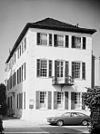
|
71 Church Street, Charleston | 1721 | House | |
| 23 King Street | 
|
23 King Street, Charleston | 1721–1755 | House | The house has been divided in apartments. |
| Strawberry Chapel | 
|
Strawberry Chapel Road, near Cordesville | 1725 | Church | |
| Thomas Fleming House | 
|
65 Broad Street, Charleston | 1725–1740[4] | House | |
| Lamboll's Tenements | 
|
8-10 Tradd Street, Charleston | 1726[5] | House | |
| Christ Church | 
|
Mount Pleasant | 1726 | Church | |
| John Cowan House | 
|
50 King Street, Charleston | 1729–1730[6] | House | |
| Edgar Wells House | 
|
52 King Street, Charleston | 1729–1730[7] | House | |
| Fairfield Plantation | 
|
McClellanville | 1730 | House | |
| Fenwick Hall | 
|
Johns Island | 1730 | House | |
| Col. George Chicken House | 
|
49 Tradd Street, Charleston | 1731[8] | House | |
| Dr. William Cleland House | 
|
60 Tradd Street, Charleston | 1732 | House | |
| Dr. Peter Fayssoux House | 
|
126 Tradd Street, Charleston | 1732[9] | House | |
| Thomas Rose House | 
|
59 Church Street, Charleston | 1733 | House | |
| Thomas Dale House | 
|
73 Church Street, Charleston | 1733[10] | House | |
| Dr. Henry Frost Office | 
|
98 Broad Street, Charleston | 1735[11] | House | |
| Hampton Plantation | 
|
McClellanville | 1735 | House | The plantation is now operated as a state park. |
| Hopsewee | 
|
South of Georgetown | 1735 | House | |
| Hext Tenements | 
|
51-53 Tradd Street, Charleston | 1736[12] | House | |
| Allston-Read House | 
|
405 Front Street, Georgetown | 1737[13] | House | |
| William Elliott House | 
|
75 King Street, Charleston | Before 1739[14] | House | |
| Thomas Lamboll House | 
|
19 King Street, Charleston | 1739 | House | A bed and breakfast operates out of the house. |
| Lucas Stearns House | 719 Prince Street, Georgetown | 1739[13] | House | ||
| Masonic Lodge | Georgetown | 1740[13] | Inn | ||
| William Vanderhorst House | 
|
54 Tradd Street, Charleston | 1740[15] | House | |
| Clark Mills Studio | 
|
51–53 Broad Street, Charleston | 1740 | House | The building is now used as commercial space. |
| Benjamin Smith House | 
|
49 Broad Street, Charleston | 1740[16] | House | |
| George Ducat House | 
|
56 Tradd Street, Charleston | 1740[17] | House | |
| Alexander Gillon House | 
|
12 Gillon Street, South Carolina | 1740[18] | House | |
| Alexander Peronneau Tenements | 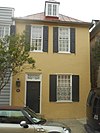
|
141 Church Street, South Carolina | 1740[19] | House | Alexander Peronneau built both this single tenement house and the neighboring double tenement at 143-145 Church St. circa 1740. |
| Pirate House | 
|
143–145 Church Street, South Carolina | 1740[20] | House | Alexander Peronneau built both this double tenement house and the neighboring single tenement at 141 Church St. circa 1740. |
| George Sommers House | 
|
43 East Bay Street, Charleston | 1740[21] | House | |
| Isaac Holmes Tenement | 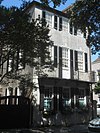
|
107 Church Street, Charleston | 1740[22] | House | |
| Withers-Porter House | 
|
316 Screven Street, Georgetown | 1740[13] | House | |
| Hall-Sellars House | 331 Screven Street, Georgetown | 1740[13] | House | ||
| Anne Boone House | 
|
47 East Bay Street, Charleston | After 1740[23] | House | |
| Othniel Beale Houses | 
|
97 and 99–101 East Bay Street, Charleston | After 1740[24] | House | |
| Stiles-Hinson House | 940 Paul Revere Drive, Charleston | 1742 | House | ||
| Brunch-Hall House | 
|
36 Meeting Street, Charleston | 1743[25] | House | |
| George Eveleigh House | 
|
39 Church Street, Charleston | 1743[26] | House | |
| George Mathews House | 
|
37 Church Street, Charleston | 1743[27] | House | |
| John McCall House | 
|
19 Tradd Street, Charleston | 1745[28] | House | |
| Taylor-Haselden House | 1032 Front Street, Georgetown | 1745[13] | House | ||
| Brewton's Corner Dependencies | 
|
35 Tradd Street, South Carolina | Before 1747[29] | House | |
| John Prue House | 
|
41 King Street, Charleston | 1746[30] | House | |
| Jonathan Badger Tenements | 
|
41–43 Tradd Street, Charleston | 1746–1772[31] | House | |
| John Drayton House | 
|
2 Ladson Street, Charleston | After 1746[32] | House | |
| Capt. Francis Baker House | 
|
79 King Street, Charleston | 1747–1749[33] | House | |
| Drayton Hall | 
|
near Charleston | 1747–1752 | House | Drayton Hall is now open to the public as a museum house. |
| Thorntree | 
|
Kingstree | 1749 | House | |
| Cabbage Row | 
|
83–85 Church Street, Charleston | 1749–1750[34] | House | |
| David Ramsay House | 
|
92 Broad Street, Charleston | Before 1750[35] | House | The house is used as a law office. |
| Capers-Motte House | 69 Church Street, Charleston | 1750[36] | House | ||
| Stewart-Congdon-Farrelly House | 513 Prince Street, Georgetown | 1750[13] | House | ||
| Ward-Bull House | 
|
614 Prince Street, Georgetown | 1750[13] | House | |
| Oakland Plantation | 
|
Mount Pleasant | 1750 | House | |
| Beneventum Plantation House | 
|
Georgetown | 1750 | House | |
| Daniel Cannon Tenement | 45 Queen Street, Charleston | 1750[37] | House | ||
| Prince George Winyah Parish Church | 
|
Broad and Highmarket Streets, Georgetown | 1750 | Church | |
| Grimke-Fraser House | 
|
102 Tradd Street, Charleston | Mid-18th century[38] | House | |
| Reardon House | Kingstree | 1750–1770 | House | ||
| Fleming-Jenkinson House | Academy Street, Kingstree | 1750–1775 | House | ||
| St. Michael's Episcopal Church | 
|
80 Broad Street, Charleston | 1751–1761 | Church | |
| James Veree Houses | 
|
58 Church Street, Charleston | 1754[39] | House | James Veree built this house in 1754 and the neighboring house at 60 Church St. a decade later. |
| Middleton Place | 
|
Summerville | 1755 | House | The remaining structure was originally a guest house for a no-longer-standing plantation house. Middleton Place is open to the public for tours of its house and gardens. |
| Ralph Izard House | 
|
110 Broad Street, Charleston | Before September 1757 | House | |
| Mansion House Hotel Annex | 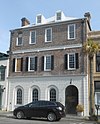
|
67–69 Broad Street, Charleston | 1758–1765[40] | House | |
| Ann Bocquet House | 
|
104 Broad Street, Charleston | After 1758[41] | House | |
| Charles Elliott House | 
|
43 Legare Street, Charleston | 1759[42] | House | |
| Justinus Stoll House | 
|
7 Stoll's Alley, Charleston | 1759[43] | House | |
| Peter Leger House | 
|
90 Church Street, Charleston | 1759–1760[44] | House | |
| Edward Rutledge House | 
|
117 Broad Street, Charleston | 1760[45] | House | The house is used as a bed and breakfast. |
| Cleland-Wells House | 
|
58 Tradd Street, Charleston | 1760 | House | |
| James Simmons House | 
|
37 Meeting Street, Charleston | 1760 | House | |
| William Cooper House | Indiantown | 1760 | House | ||
| Samuel Wainwright House | 
|
94 Tradd Street, Charleston | 1760 | House | |
| Thomas Hepworth House | 214 New Street, Beaufort | 1760[46] | House | Possibly the oldest house in Beaufort, South Carolina. Could have been built as early as 1720. | |
| Joseph H. Rainey House | 
|
909 Prince Street, Georgetown | 1760 | House | |
| Bolen-Bellune House | 222 Broad Street, Georgetown | 1760[13] | House | ||
| Harold Kaminski House | 1003 Front Street, Georgetown | 1760[13] | House | ||
| Pawley-Parker House | 
|
1019 Front Street, Georgetown | 1760[13] | House | |
| Humley-Miller House | 331 Screven Street, Georgetown | 1760[13] | House | ||
| Daniel Elliott Huger House | 
|
34 Meeting Street, Charleston | 1760 | House | |
| Pacey House | 601 Highmarket Street, Georgetown | 1760[13] | House | ||
| Daniel Legare House | 
|
79 Anson Street, Charleston | 1760[47] | House | |
| 25 Meeting Street | 
|
25 Meeting Street, Charleston | 1760[48] | House | |
| Tucker-Smith-Tarbox House | 15 Cannon Street, Georgetown | 1760[13] | House | ||
| Cooper-Bee House | 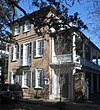
|
94 Church Street, South Carolina | 1760–1765[49] | House | |
| Thomas Elfe House | 
|
54 Queen Street, South Carolina | 1760–1770[50] | House | |
| Edward Blake House | 
|
1 Legare Street, Charleston | 1760–1770[51] | House | |
| Blake Tenements | 
|
2–4 Courthouse Square, Charleston | 1760–1772 | Rental townhouses | The houses are used as offices for Charleston County. |
| Grimke-Fraser Tenements | 
|
55 King Street, Charleston | 1762[52] | House | |
| Dewar-Lee-Pringle House | 
|
92 Tradd Street, Charleston | 1762[53] | House | |
| John Rutledge House | 
|
116 Broad Street, Charleston | 1763 | House | The house is used as a bed-and-breakfast. |
| Pompion Hill Chapel | 
|
Huger | 1763 | Church | |
| Charles Elliott House | 
|
22 Legare Street, Charleston | 1764 | House | |
| James Veree Houses | 
|
60 Church Street, Charleston | 1764[54] | House | James Veree built this house in 1764 and the neighboring house at 58 Church St. a decade earlier. |
| Guillebeau House | 
|
Willington | 1764 | House | |
| Fotheringham-McNeil Tenements | 
|
72 Tradd Street, Charleston | Before 1765[55] | House | |
| Humphrey Sommers House | 
|
128 Tradd Street, Charleston | 1765[56] | House | |
| Walnut Grove Plantation | 
|
Roebuck | 1765 | House | |
| Branford-Horry House | 
|
59 Meeting Street, Charleston | Before 1767 | House | |
| Old St. Michael's Rectory | 
|
39 Meeting Street, Charleston | 1767 | House | |
| McCrady's Tavern and Long Room | 
|
153 East Bay Street, Charleston | 1767 | House | A restaurant by the same name operates in the building. |
| St. Stephens Episcopal Church | 
|
St. Stephen | 1767–1769 | Church | |
| Exchange and Provost | 
|
122 East Bay Street, Charleston | 1767-177 | Royal custom house | The building is open as a museum. |
| William Washington House | 
|
8 South Battery, Charleston | 1768 | House | |
| Elizabeth Petrie House | 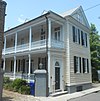
|
3 Orange Street, Charleston | 1768[57] | House | |
| St. James Episcopal Church | 
|
McClellanville | 1768 | Church | |
| Miles Brewton House | 
|
27 King Street, Charleston | 1769 | House | |
| Charles Pinckney House | 
|
7 Orange Street, Charleston | 1769[58] | House | |
| Young-Keenan House | 14 Water Street, Charleston | 1769[59] | House | ||
| John Rose House | 
|
43 Church Street, Charleston | 1769–1775[60] | House | |
| Rev. Robert Smith House | 
|
6 Glebe Street, Charleston | 1770 | House | Residence of the president of the College of Charleston |
| Peter Bocquet, Jr. House | 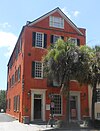
|
95 Broad Street, Charleston | 1770 | House | |
| McGrath House | 220 Queen Street, Georgetown | 1770[13] | House | ||
| Humley-Miller House | 1024 Front Street, Georgetown | 1770[13] | House | ||
| Fraser House | 1028 Front Street, Georgetown | 1770[13] | House | ||
| Simons Tenements | 
|
9–11 Orange Street, Charleston | 1770[61] | House | |
| Greenwich Plantation | 320 St. James Street, Georgetown | 1773[13] | House | All of the original building that remains is the detached kitchen, later converted into an art studio and then house. | |
| Young-Motte House | 
|
30 Meeting Street, Charleston | 1770 | House | |
| Albert Detmar House | 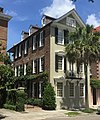
|
23 Meeting Street, Charleston | 1770[62] | House | |
| Withers-Kaminski House | 
|
622 Highmarket Street, Georgetown | 1770[13] | House | |
| John Edwards House | 
|
15 Meeting Street, Charleston | 1770 | House | |
| Young-Johnson House | 
|
35 Church Street, Charleston | 1770[63] | House | |
| William Harvey House | 
|
58 Meeting Street, Charleston | 1770 | House | |
| James Vanderhorst House | 
|
46–48 Tradd Street, Charleston | 1770[64] | House | |
| Elliott House | Richburg | 1770 c. | House | ||
| Pegues Place | 
|
Wallace | 1770 c. | House | |
| Laurance Corley House | 
|
231 Fox Street, Lexington | 1771 | House | Now located on the grounds of the Lexington County Museum. The oldest structure in the town of Lexington. |
| John Scott House | 
|
38 Coming Street, Charleston | 1771[65] | House | |
| Geiger House | 
|
54 Broad Street, Charleston | 1771–1775[66] | House | |
| Heyward-Washington House | 
|
87 Church Street, Charleston | 1772 | House | The house is open to the public as a museum operated by the Charleston Museum. |
| Colonel John Stuart House | 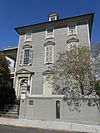
|
104–106 Tradd Street, Charleston | 1772 | House | |
| John Fullerton House | 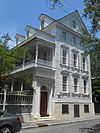
|
15 Legare Street, Charleston | 1772 | House | |
| Unitarian Church | 
|
4 Archdale Street, Charleston | 1772–1787 | Church | |
| William Gibbes House | 
|
64 South Battery, Charleston | 1772–1788 | House | |
| Philip Porcher House | 
|
19 Archdale Street, Charleston | 1773[67] | House | |
| Lewisfield Plantation | 
|
Moncks Corner | 1774 | House | |
| Robert Pringle House | 
|
70 Tradd Street, Charleston | 1774[68] | House | |
| Robert Hayne House | 
|
30 King Street, Charleston | Before 1775[69] | House | |
| Kincaid-Anderson House | 
|
Jenkinsville | 1774 | House | |
| Man-Doyle House | 
|
528 Front Street, Georgetown | 1775[13] | House | |
| Bonham House | Saluda, SC | 1780 | House | ||
| Blocker House | 
|
Route 25, near Edgefield | 1790 c. | House | |
| Seibels House | 
|
Columbia | 1796 | House | Oldest house in the state capital |
| Elizabeth Hext House | 
|
207 Hancock Street, Beaufort | 1800[70] | House | One of the earliest surviving houses using tabby concrete. Dated with dendochronology. |
| Congregation Kahal Kadosh Beth Elohim | 
|
Charleston | 1840 | Synagogue | Oldest Jewish synagogue in South Carolina |
See also
editReferences
edit- ^ Poston, Jonathan (1997). The Buildings of Charleston. Columbia, South Carolina: University of South Carolina Press. p. 203.
- ^ Poston, Jonathan (1997). The Buildings of Charleston. Columbia, South Carolina: University of South Carolina Press. p. 143.
- ^ Poston, Jonathan (1997). The Buildings of Charleston. Columbia, South Carolina: University of South Carolina Press. pp. 258–259.
- ^ Poston, Jonathan (1997). The Buildings of Charleston. Columbia, South Carolina: University of South Carolina Press. p. 164.
- ^ Poston, Jonathan (1997). The Buildings of Charleston. Columbia, South Carolina: University of South Carolina Press. pp. 138–139.
- ^ Poston, Jonathan (1997). The Buildings of Charleston. Columbia, South Carolina: University of South Carolina Press. p. 232.
- ^ Poston, Jonathan (1997). The Buildings of Charleston. Columbia, South Carolina: University of South Carolina Press. p. 232.
- ^ Poston, Jonathan (1997). The Buildings of Charleston. Columbia, South Carolina: University of South Carolina Press. p. 145.
- ^ Poston, Jonathan (1997). The Buildings of Charleston. Columbia, South Carolina: University of South Carolina Press. pp. 288–289.
- ^ Poston, Jonathan (1997). The Buildings of Charleston. Columbia, South Carolina: University of South Carolina Press. p. 73.
- ^ Poston, Jonathan (1997). The Buildings of Charleston. Columbia, South Carolina: University of South Carolina Press. pp. 174–175.
- ^ Poston, Jonathan (1997). The Buildings of Charleston. Columbia, South Carolina: University of South Carolina Press. pp. 145–146.
- ^ a b c d e f g h i j k l m n o p q r s t Ruhf, Nancy R. (1971). "National Register of Historic Places Inventory – Nomination Form" (PDF). Georgetown, South Carolina Nomination. South Carolina Department of Archives and History. Retrieved May 18, 2014.
- ^ Poston, Jonathan (1997). The Buildings of Charleston. Columbia, South Carolina: University of South Carolina Press. p. 233.
- ^ Poston, Jonathan (1997). The Buildings of Charleston. Columbia, South Carolina: University of South Carolina Press. pp. 146–147.
- ^ Poston, Jonathan (1997). The Buildings of Charleston. Columbia, South Carolina: University of South Carolina Press. p. 160.
- ^ Poston, Jonathan (1997). The Buildings of Charleston. Columbia, South Carolina: University of South Carolina Press. p. 147.
- ^ Poston, Jonathan (1997). The Buildings of Charleston. Columbia, South Carolina: University of South Carolina Press. p. 119.
- ^ Poston, Jonathan (1997). The Buildings of Charleston. Columbia, South Carolina: University of South Carolina Press. pp. 86–87.
- ^ Poston, Jonathan (1997). The Buildings of Charleston. Columbia, South Carolina: University of South Carolina Press. pp. 86–87.
- ^ Poston, Jonathan (1997). The Buildings of Charleston. Columbia, South Carolina: University of South Carolina Press. p. 92.
- ^ Poston, Jonathan (1997). The Buildings of Charleston. Columbia, South Carolina: University of South Carolina Press. p. 178.
- ^ Poston, Jonathan (1997). The Buildings of Charleston. Columbia, South Carolina: University of South Carolina Press. p. 94.
- ^ Poston, Jonathan (1997). The Buildings of Charleston. Columbia, South Carolina: University of South Carolina Press. pp. 104–105.
- ^ Poston, Jonathan (1997). The Buildings of Charleston. Columbia, South Carolina: University of South Carolina Press. p. 259.
- ^ Poston, Jonathan (1997). The Buildings of Charleston. Columbia, South Carolina: University of South Carolina Press. pp. 216–217.
- ^ Poston, Jonathan (1997). The Buildings of Charleston. Columbia, South Carolina: University of South Carolina Press. p. 215.
- ^ Poston, Jonathan (1997). The Buildings of Charleston. Columbia, South Carolina: University of South Carolina Press. pp. 140–141.
- ^ Poston, Jonathan (1997). The Buildings of Charleston. Columbia, South Carolina: University of South Carolina Press. p. 143.
- ^ Poston, Jonathan (1997). The Buildings of Charleston. Columbia, South Carolina: University of South Carolina Press. pp. 230–231.
- ^ Poston, Jonathan (1997). The Buildings of Charleston. Columbia, South Carolina: University of South Carolina Press. p. 144.
- ^ Poston, Jonathan (1997). The Buildings of Charleston. Columbia, South Carolina: University of South Carolina Press. pp. 235–236.
- ^ Poston, Jonathan (1997). The Buildings of Charleston. Columbia, South Carolina: University of South Carolina Press. p. 233.
- ^ Poston, Jonathan (1997). The Buildings of Charleston. Columbia, South Carolina: University of South Carolina Press. p. 76.
- ^ Poston, Jonathan (1997). The Buildings of Charleston. Columbia, South Carolina: University of South Carolina Press. pp. 172–173.
- ^ Poston, Jonathan (1997). The Buildings of Charleston. Columbia, South Carolina: University of South Carolina Press. pp. 71–72.
- ^ Poston, Jonathan (1997). The Buildings of Charleston. Columbia, South Carolina: University of South Carolina Press. pp. 190–191.
- ^ Poston, Jonathan (1997). The Buildings of Charleston. Columbia, South Carolina: University of South Carolina Press. p. 283.
- ^ Poston, Jonathan (1997). The Buildings of Charleston. Columbia, South Carolina: University of South Carolina Press. pp. 67–68.
- ^ Poston, Jonathan (1997). The Buildings of Charleston. Columbia, South Carolina: University of South Carolina Press. pp. 164–165.
- ^ Poston, Jonathan (1997). The Buildings of Charleston. Columbia, South Carolina: University of South Carolina Press. p. 176.
- ^ Poston, Jonathan (1997). The Buildings of Charleston. Columbia, South Carolina: University of South Carolina Press. p. 250.
- ^ Poston, Jonathan (1997). The Buildings of Charleston. Columbia, South Carolina: University of South Carolina Press. pp. 136–137).
- ^ Poston, Jonathan (1997). The Buildings of Charleston. Columbia, South Carolina: University of South Carolina Press. p. 80.
- ^ Poston, Jonathan (1997). The Buildings of Charleston. Columbia, South Carolina: University of South Carolina Press. pp. 206–207.
- ^ "Thomas Hepworth House – 214 New Street, Beaufort SC". Beaufort Online. Retrieved May 19, 2014.
- ^ Poston, Jonathan (1997). The Buildings of Charleston. Columbia, South Carolina: University of South Carolina Press. p. 424.
- ^ Poston, Jonathan (1997). The Buildings of Charleston. Columbia, South Carolina: University of South Carolina Press. p. 256.
- ^ Poston, Jonathan (1997). The Buildings of Charleston. Columbia, South Carolina: University of South Carolina Press. pp. 80–81.
- ^ Poston, Jonathan (1997). The Buildings of Charleston. Columbia, South Carolina: University of South Carolina Press. p. 128.
- ^ Poston, Jonathan (1997). The Buildings of Charleston. Columbia, South Carolina: University of South Carolina Press. p. 239.
- ^ Poston, Jonathan (1997). The Buildings of Charleston. Columbia, South Carolina: University of South Carolina Press. p. 232.
- ^ Poston, Jonathan (1997). The Buildings of Charleston. Columbia, South Carolina: University of South Carolina Press. p. 282.
- ^ Poston, Jonathan (1997). The Buildings of Charleston. Columbia, South Carolina: University of South Carolina Press. pp. 67–68.
- ^ Poston, Jonathan (1997). The Buildings of Charleston. Columbia, South Carolina: University of South Carolina Press. pp. 280–281.
- ^ Poston, Jonathan (1997). The Buildings of Charleston. Columbia, South Carolina: University of South Carolina Press. p. 289.
- ^ Poston, Jonathan (1997). The Buildings of Charleston. Columbia, South Carolina: University of South Carolina Press. p. 265.
- ^ Poston, Jonathan (1997). The Buildings of Charleston. Columbia, South Carolina: University of South Carolina Press. p. 265.
- ^ Poston, Jonathan (1997). The Buildings of Charleston. Columbia, South Carolina: University of South Carolina Press. p. 152.
- ^ Poston, Jonathan (1997). The Buildings of Charleston. Columbia, South Carolina: University of South Carolina Press. p. 217.
- ^ Poston, Jonathan (1997). The Buildings of Charleston. Columbia, South Carolina: University of South Carolina Press. p. 266.
- ^ Poston, Jonathan (1997). The Buildings of Charleston. Columbia, South Carolina: University of South Carolina Press. p. 256.
- ^ Poston, Jonathan (1997). The Buildings of Charleston. Columbia, South Carolina: University of South Carolina Press. p. 214.
- ^ Poston, Jonathan (1997). The Buildings of Charleston. Columbia, South Carolina: University of South Carolina Press. pp. 144–145.
- ^ Poston, Jonathan (1997). The Buildings of Charleston. Columbia, South Carolina: University of South Carolina Press. p. 519.
- ^ Poston, Jonathan (1997). The Buildings of Charleston. Columbia, South Carolina: University of South Carolina Press. pp. 161–162.
- ^ Poston, Jonathan (1997). The Buildings of Charleston. Columbia, South Carolina: University of South Carolina Press. p. 342.
- ^ Poston, Jonathan (1997). The Buildings of Charleston. Columbia, South Carolina: University of South Carolina Press. p. 266.
- ^ Poston, Jonathan (1997). The Buildings of Charleston. Columbia, South Carolina: University of South Carolina Press. p. 230.
- ^ "Hext House, 207 Hancock Street, Beaufort, South Carolina". Oxford Tree-Ring Laboratory. Retrieved January 17, 2024.